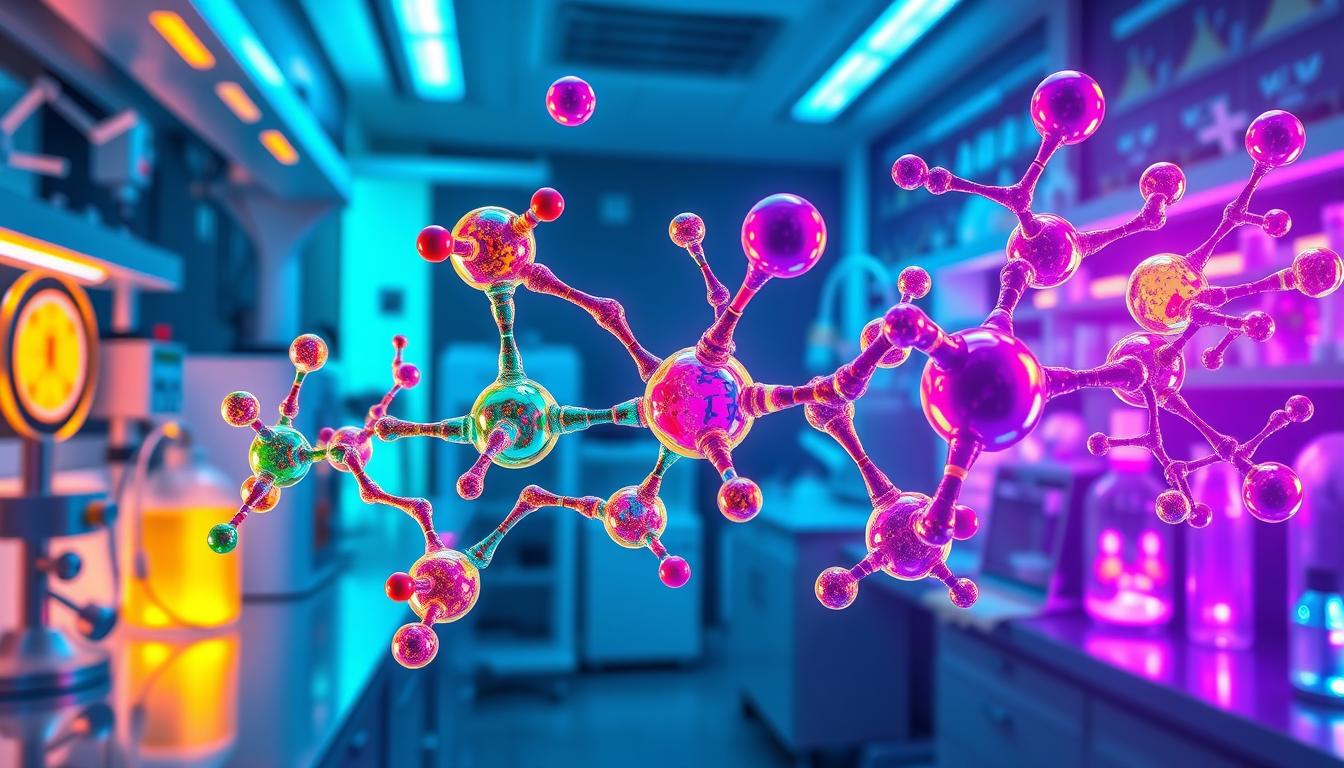The Top FDA-Approved Peptides and How They’re Shaping Modern Medicine

FDA-approved peptides are changing modern medicine, especially for type 2 diabetes and obesity. Glucagon-like peptide-1 receptor agonists (GLP-1RA) are better than other drugs for controlling blood sugar, losing weight, and lowering blood pressure. They also protect the heart without the danger of low blood sugar1.
The FDA has approved several GLP-1 receptor agonists for managing blood sugar and weight. These include dulaglutide, exenatide, liraglutide, semaglutide, and tirzepatide1. These peptides are changing how we manage diabetes and are being studied for their benefits in heart and kidney health.
Key Takeaways
- FDA-approved peptides, especially GLP-1 receptor agonists, are changing how we treat type 2 diabetes and obesity.
- These peptides offer better blood sugar control, weight loss, and heart benefits than other drugs.
- The FDA has approved several GLP-1 receptor agonists, including dulaglutide, exenatide, liraglutide, semaglutide, and tirzepatide, for managing type 2 diabetes and weight loss.
- Peptide therapies are considered safe with few side effects, and their costs vary based on individual needs.
- It’s important to talk to a healthcare provider to find the right peptide therapy for each patient.
Understanding Peptide Therapeutics in Modern Medicine
Peptide-based treatments are changing medicine by using natural processes. These drugs, like GLP-1 receptor agonists, help make insulin, reduce hunger, and grow beta-cells2. They have become more effective and safer, helping with more than just diabetes.
The Science Behind Peptide-Based Treatments
Role of Peptides in Biological Functions
Evolution of Peptide Medicine
“Peptides are unable to effectively cross the cell membrane to target intracellular molecules, limiting their applications in drug development.”2
Despite challenges, peptide drugs show great promise. Antibiotics like vancomycin and daptomycin have been approved3. As peptide medicine grows, we’ll see more effective treatments, changing healthcare.
FDA-Approved Peptides: Current Landscape and Classifications
The world of therapeutic peptides is growing fast. The FDA has approved over 60 peptide-based drugs for use in the US, Europe, Japan, and other big markets4. This shows how much medicine is changing with the help of peptides.
Some top peptide drugs are GLP-1 receptor agonists like dulaglutide and liraglutide. They help control blood sugar and aid in weight loss5. In 2019, dulaglutide made $4.4 billion, and liraglutide made $4.1 billion. This shows how popular they are.
The rules for peptide drugs are getting clearer. The FDA is being more careful about making sure they are safe5. This means more research and testing before these drugs can be used.
| Peptide Therapeutic | Indication | Sales (2019) |
|---|---|---|
| Dulaglutide | Diabetes, Weight Loss | $4.4 billion |
| Liraglutide | Diabetes, Obesity | $4.1 billion |
| Leuprorelin | Cancer Treatment | $2.0 billion |
The market for peptide drugs is growing fast. More peptide drugs are being tested in clinical trials than ever before5. This shows the exciting future of therapeutic peptides, peptide formulations, and peptide research.

Peptide drugs come from different sources. They can be synthetic human hormones, made from animals, plants, or bacteria5. This variety shows how flexible and useful peptides can be in treating many health issues.
Glucagon-Like Peptide-1 (GLP-1) Receptor Agonists
Glucagon-like peptide-1 (GLP-1) receptor agonists are a new class of medicines. They work by making more insulin, less glucagon, and slowing down how fast food leaves the stomach. This helps control blood sugar levels in people with type 2 diabetes6.
Mechanism of Action
These medicines target the GLP-1 receptor in our bodies. They act like the natural GLP-1 hormone to help control blood sugar. They also slow down how fast food leaves the stomach, which helps keep blood sugar levels stable6.
Clinical Applications
GLP-1 analogs are not just for type 2 diabetes. Exenatide, Liraglutide, Dulaglutide, and Semaglutide are approved by the FDA for T2DM6. Semaglutide and high-dose Liraglutide also help with obesity or being overweight6. They might even help with type 1 diabetes, improving blood sugar control and weight loss6.
Treatment Outcomes
Studies show GLP-1 receptor agonists are very effective. They improve blood sugar control, help with weight loss, and lower heart disease risks. Semaglutide, subcutaneous Semaglutide, and Dulaglutide have been shown to reduce heart disease risk in people with a history of heart disease6.
They also help with weight loss and lower blood pressure and cholesterol. GLP-1 analogs have been shown to lower death rates and improve blood sugar levels in T2DM patients6.

In summary, GLP-1 receptor agonists have changed how we treat type 2 diabetes and are now used for obesity, heart disease, and type 1 diabetes. Their success and safety make them a key part of modern medicine7.
Therapeutic Applications in Metabolic Disorders
FDA-approved peptides have changed the game in treating metabolic disorders like type 2 diabetes and obesity8. GLP-1 receptor agonists, such as semaglutide and liraglutide, have shown great results in weight loss and blood sugar control8. They help manage these conditions and also reduce the risk of heart disease8.
These peptide treatments have sparked more research into their uses in other diseases8. With over 400 peptide drugs in development worldwide, and 60 already approved, the future looks bright8. The industry expects a 9.1% growth rate from 2016 to 2024, thanks to the rise in metabolic diseases and cancers8.
| Peptide Drug | Indication | FDA Approval Year |
|---|---|---|
| Insulin | Diabetes mellitus | 1923 |
| Corticotropin | Steroid-responsive disorders, multiple sclerosis, infantile spasms | 1952 |
| Cyclosporine | Immunosuppressant | 1983 |
| Glucagon | Hypoglycemia management | 1998 |
| Secretin | Regulation of gastric acid, pancreatic bicarbonate, and osmoregulation | 2002 |
| Vasopressin | Increased blood pressure in adults with vasodilatory shock | 2014 |
| Parathyroid hormone (PTH) | Controlling hypocalcemia in patients with hypoparathyroidism | 2015 |
| Angiotensin II | Vasoconstrictor for increasing blood pressure in specific conditions | 2017 |
“The potential of peptide therapeutics is significant, with promising treatments for conditions like HIV-1 using drugs such as enfuvirtide and for short bowel syndrome with teduglutide, showcasing the versatility of peptides in medical treatments.”8
Cardiovascular and Renal Benefits of Peptide Therapies
Peptide therapies, especially GLP-1 receptor agonists, show great benefits for the heart and kidneys. These treatments are seen as promising for managing heart and metabolic issues. They protect the heart and kidneys well.
Impact on Heart Health
Kidney Function Improvement
Peptide therapies also help the kidneys. Research shows they reduce kidney damage and slow kidney function decline10. Dulaglutide, in particular, is good for those with kidney disease, showing its kidney-protective effects.
Clinical Evidence and Studies
Many studies prove the heart and kidney benefits of peptide therapies. This has led to FDA approvals for heart risk reduction and for patients with kidney issues10. The growing evidence supports using these treatments in medicine.

“The clinical evidence on the cardiovascular and renal benefits of peptide-based therapies is truly compelling, offering healthcare providers and patients new avenues for managing complex cardiometabolic conditions.”
Safety Profile and Regulatory Considerations
The safety of FDA-approved peptide drugs is mostly good, with most side effects being in the stomach11. But, the FDA has recently taken steps to be more careful with compounded peptides. They banned some peptides like BPC-157 and AOD-9604 because of worries about impurities and how they might cause immune reactions11. This change shows how important it is to follow FDA-approved formulas and doses for safety and effectiveness.
| Key Regulatory Considerations for Peptide Therapeutics |
|---|
|
“The FDA’s regulatory actions emphasize the importance of adhering to approved formulations and dosages to ensure patient safety and treatment efficacy.”
Emerging Trends in Peptide Development
The world of peptide science is changing fast. New delivery systems and peptides are being developed. Recent data14 shows that in 2023, three out of six peptide drugs approved were macrocyclic peptides. This is 50% of all approvals14. It shows a big interest in new peptide structures to make them more stable and less likely to cause an immune reaction.
Innovation in Delivery Systems
One big step is making oral forms of peptides that used to be injected. Oral semaglutide’s success has opened doors15 for other peptides. This could make treatments easier for patients to follow15. Also, scientists are making peptides more effective by changing their chemical makeup and adding them to delivery systems.
Next-Generation Peptides
Researchers are working on peptides that are more stable and target specific areas better. For example, Zosurabalpin was picked from 45,000 cyclic peptides and has shown safety in two Phase I trials14. Tirzepatide, a multi-receptor agonist, shows the potential to treat more than one condition at a time14.
These new developments in peptide science, novel peptides, and drug delivery systems are leading to better treatments. The FDA’s approval of new peptide drugs like BT8009 and LUNA18 shows the field’s bright future14.
| Emerging Trend | Description |
|---|---|
| Oral Peptide Formulations | Developing oral dosage forms for traditionally injectable peptides, as seen with the success of oral semaglutide. |
| Chemical Modifications | Employing strategies like cyclization, D-amino acid substitution, peptoid formation, N-methylation, and side chain halogenation to enhance stability and efficacy. |
| Multi-Receptor Agonists | Designing peptides that target multiple receptors or pathways for synergistic therapeutic effects, as demonstrated by tirzepatide. |
“The approval of oral semaglutide (Rybelsus®) in 2019 for treating type 2 diabetes marked a significant milestone in peptide therapeutics.”16
Future Directions in Peptide Medicine
The future of peptide medicine looks bright, with new research and applications on the horizon. The global peptide drug market is set to grow, reaching $49.5 billion by17. This growth is driven by the field’s evolution and its aim to meet unmet medical needs. Focus areas include peptides for neurodegenerative diseases, cancer, and personalized medicine.
Artificial intelligence and machine learning are set to speed up the creation of new therapeutic peptides. Currently, over 170 peptides are in clinical trials, with many more in preclinical stages17. This shows the vast potential of peptide-based treatments. As research progresses, peptides with better efficacy, safety, and easier administration are being developed.
The future of peptide research frontiers and personalized peptide therapy is exciting. The future of peptides is set to change modern medicine. In 2019, peptide drug sales hit over $70 billion, a big jump from 20132. This highlights the increasing role of peptide-based treatments in medicine.
FAQ
What are FDA-approved peptides and how are they transforming modern medicine?
FDA-approved peptides, like GLP-1 receptor agonists, are changing how we treat type 2 diabetes and obesity. They work better than other treatments by controlling blood sugar, helping with weight loss, and lowering heart disease risks.
How do peptide therapeutics work and what is their role in biological functions?
Peptide therapeutics mimic natural processes. They help release insulin, slow down stomach emptying, and control blood sugar levels. They’ve become more effective and are used for more than just diabetes.
What is the current landscape of FDA-approved peptide drugs and how are they classified?
The FDA has approved several peptide drugs, including GLP-1 receptor agonists like dulaglutide and semaglutide. These drugs come in forms that you inject or take by mouth. The FDA is also working to ensure these drugs are safe by limiting certain types of compounding.
How do GLP-1 receptor agonists work, and what are their clinical applications?
GLP-1 receptor agonists help control blood sugar, aid in weight loss, and lower heart disease risks. They’re used to treat type 2 diabetes and obesity. They might also help with type 1 diabetes and weight management.
What are the therapeutic applications of FDA-approved peptides in metabolic disorders?
Peptides like semaglutide and liraglutide are effective against type 2 diabetes and obesity. They improve blood sugar control, help with weight loss, and may reduce heart disease risks. They’re a key part of managing metabolic health.
What are the cardiovascular and renal benefits of peptide therapies?
Peptide therapies, especially GLP-1 receptor agonists, offer heart and kidney benefits. Studies show they lower heart disease risks and improve kidney function. This has led to FDA approvals for heart health and use in patients with kidney issues.
What is the safety profile of FDA-approved peptides, and what regulatory considerations are in place?
FDA-approved peptides are generally safe, with most side effects being stomach-related. However, the FDA has banned compounding certain peptides due to safety concerns. It’s crucial to use FDA-approved forms and doses.
What are the emerging trends and future directions in peptide development?
Peptide development is moving towards better delivery methods, like oral forms. Next-generation peptides aim for better stability, target specificity, and safety. Research is also exploring new uses, like for neurodegenerative diseases and cancer. Artificial intelligence and machine learning will help find new peptides faster.
Source Links
- https://www.ncbi.nlm.nih.gov/books/NBK572151/ – Compare and Contrast the Glucagon-Like Peptide-1 Receptor Agonists (GLP1RAs) – StatPearls
- https://www.nature.com/articles/s41392-022-00904-4 – Therapeutic peptides: current applications and future directions – Signal Transduction and Targeted Therapy
- https://pmc.ncbi.nlm.nih.gov/articles/PMC10609221/ – Peptides as Therapeutic Agents: Challenges and Opportunities in the Green Transition Era
- https://link.springer.com/article/10.1007/s10989-022-10477-z – Recent Patents and FDA-Approved Drugs Based on Antiviral Peptides and Other Peptide-Related Antivirals – International Journal of Peptide Research and Therapeutics
- https://synapse.patsnap.com/blog/development-trends-of-peptide-pharmaceuticals – Development Trends of Peptide Pharmaceuticals
- https://www.ncbi.nlm.nih.gov/books/NBK551568/ – Glucagon-Like Peptide-1 Receptor Agonists – StatPearls
- https://my.clevelandclinic.org/health/treatments/13901-glp-1-agonists – GLP-1 Agonists
- https://www.news-medical.net/health/The-Potential-of-Peptide-Therapeutics-in-Treating-Chronic-Diseases.aspx – The Potential of Peptide Therapeutics in Treating Chronic Diseases
- https://pmc.ncbi.nlm.nih.gov/articles/PMC10968328/ – Exploring FDA-Approved Frontiers: Insights into Natural and Engineered Peptide Analogues in the GLP-1, GIP, GHRH, CCK, ACTH, and ?-MSH Realms
- https://pmc.ncbi.nlm.nih.gov/articles/PMC5216031/ – The Potential Therapeutic Application of Peptides and Peptidomimetics in Cardiovascular Disease
- https://www.fda.gov/media/107622/download – Guidance for Industry- Synthetic Peptides
- https://www.fda.gov/media/171901/download – Clinical Pharmacology Considerations for Peptide Drug Products | Level 2 Guidance
- https://pmc.ncbi.nlm.nih.gov/articles/PMC8876803/ – 2021 FDA TIDES (Peptides and Oligonucleotides) Harvest
- https://www.biochempeg.com/article/406.html – Advances in Macrocyclic Peptide Drug Development
- https://brieflands.com/articles/jjnpp-134049 – Current Status of Peptide Medications and the Position of Active Therapeutic Peptides with Scorpion Venom Origin
- https://pmc.ncbi.nlm.nih.gov/articles/PMC10330351/ – Recent Advances in the Development of Therapeutic Peptides
- https://www.biochempeg.com/article/286.html – Peptide Therapeutics: Current Status And Future Directions












